
Page 27
http://threesology.org
Note: the contents of this page as well as those which precede and follow, must be read as a continuation and/or overlap in order that the continuity about a relationship to/with the typical dichotomous assignment of Artificial Intelligence (such as the usage of zeros and ones used in computer programming) as well as the dichotomous arrangement of the idea that one could possibly talk seriously about peace from a different perspective... will not be lost (such as war being frequently used to describe an absence of peace and vice-versa). However, if your mind is prone to being distracted by timed or untimed commercialization (such as that seen in various types of American-based television, radio, news media and magazine publishing... not to mention the average classroom which carries over into the everyday workplace), you may be unable to sustain prolonged exposures to divergent ideas about a singular topic without becoming confused, unless the information is provided in a very simplistic manner.
Computers have metamorphocized into a creature that is just another stage awaiting to mature beyond its initial beginnings. And by using such a reference, we need to look at metamorphosis... those that are readily known (such as in insects), those taken for granted (such as human development), and those not only uncommonly referred to); but those we will have to pay witness to and give description of for the first time. All too often people forget that the development of humanity is an on-going metamorphosis, though it is referred to as evolution. We of today are not the epitome of human development. We are a go-between stage. One of the metamorphosis taking place in the minds of some is that which comes after life. Humans are thought to be provided with three alternatives decided on by their conduct in this life. (Hell- Purgatory- Heaven) Such an idea is a cognitive pattern. If you were take the same pattern and put it into another subject area that uses a different dictionary of terms, you might instead refer to id- ego- superego, or x-axis- y-axis- z-axis, or pitch- roll- yaw (aircraft stability). Unfortunately, many minds are not particularly flexible... they engage in their own formulas of self-centered fixedness.
(Metamorphosis) in biology, (refers to a) striking change of form or structure in an individual after hatching or birth. Hormones called molting and juvenile hormones, which are not species specific, apparently regulate the changes. These physical changes as well as those involving growth and differentiation are accompanied by alterations of the organism's physiology, biochemistry, and behaviour. The immature forms, or larvae, are adapted to environments and modes of life that differ from those of the adult forms. These differences may be of significance in assuring that larvae and adults of the same species do not engage in direct competition for food or living space. Examples of metamorphosis include the tadpole, an aquatic larval stage that transforms into the land-dwelling frog (class Amphibia). Starfishes and other echinoderms undergo a metamorphosis that includes a change from the bilateral symmetry of the larva to the radial symmetry of the adult. Metamorphic patterns are well-known in crabs, lobsters, and other crustaceans and also in snails, clams, and other mollusks. The larval form of the urochordate (e.g., the tunicate, or sea squirt) is tadpole-like and free swimming; the adult is sessile and somewhat degenerate. Among the most dramatic and thoroughly studied examples of metamorphosis are the insects. Because development is not the same in all insects, it is convenient to group them into major categories according to the pattern of structural changes:
Hypermetamorphosis, a form of complete metamorphosis, occurs in some beetles, flies, and other insects and is characterized by a series of larval stages. Source: "Metamorphosis." Encyclopædia Britannica Ultimate Reference Suite, 2013. |
The intermediate stages of metamorphosis can permit a degree of flexibility that adult variations do not have. Since environmental conditions are dynamic (changing) processes, it is of value that a species has a means of altering the final stages of adaptation in order to make its chances for survival more viable. Such a situation leads us to consider that a trinary circuit must incorporate a structure of metamorphosis... the very structure that those working with binary circuits are trying to incorporate for flexibility... a rather necessary component for advanced forms of Artificial Intelligence. Interestingly however, our machines take on systems which reflect, or replicate the process witness in biology. It's no wonder that some are looking into the development of a biologically-based Artificial Intelligence.
Metamorphosis is like a type of miniaturized movie of an evolutionary process, that we might align with Ernst Haeckel's ideas on developmental biology. The human body is a similar type of replay... with the replay of the brain's evolutionary development easily recognized. What is not easily recognized is how the mind of many people progress through developmental stages or types of perception that seem characteristic of past ages... and in fact some people claim they are better suited for another time and place in the past or some assumed future. Others think themselves more suited to a different place (cultural setting) and find a means to move. Another representation of cross-species matching of form or function can be found in the idea of Homology. (Please do not lose sight of the fact that we are seeking some form and function that is better suited for advancing the age of computers. But your thinking must be open to new tactics as a methodology in attempting this. Lots of different subject matter and materials need to be surveyed, just like Thomas Edison did when seeking the right material for a light bulb filament. A reference to Edison and his light bulb filament will be provided first, Followed by a reference to Homology.)
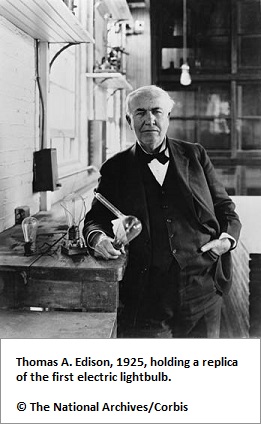
...Another offshoot of the carbon experiments reached fruition sooner. Samuel Langley, Henry Draper, and other American scientists needed a highly sensitive instrument that could be used to measure minute temperature changes in heat emitted from the Sun's corona during a solar eclipse along the Rocky Mountains on July 29, 1878. To satisfy those needs Edison devised a “microtasimeter” employing a carbon button. This was a time when great advances were being made in electric arc lighting, and during the expedition, which Edison accompanied, the men discussed the practicality of “subdividing” the intense arc lights so that electricity could be used for lighting in the same fashion as with small, individual gas “burners.” The basic problem seemed to be to keep the burner, or bulb, from being consumed by preventing it from overheating. Edison thought he would be able to solve this by fashioning a microtasimeter-like device to control the current. He boldly announced that he would invent a safe, mild, and inexpensive electric light that would replace the gaslight. The incandescent electric light had been the despair of inventors for 50 years, but Edison's past achievements commanded respect for his boastful prophecy. Thus, a syndicate of leading financiers, including J.P. Morgan and the Vanderbilts, established the Edison Electric Light Company and advanced him $30,000 for research and development. Edison proposed to connect his lights in a parallel circuit by subdividing the current, so that, unlike arc lights, which were connected in a series circuit, the failure of one lightbulb would not cause a whole circuit to fail. Some eminent scientists predicted that such a circuit could never be feasible, but their findings were based on systems of lamps with low resistance—the only successful type of electric light at the time. Edison, however, determined that a bulb with high resistance would serve his purpose, and he began searching for a suitable one. He had the assistance of 26-year-old Francis Upton, a graduate of Princeton University with an M.A. in science. Upton, who joined the laboratory force in December 1878, provided the mathematical and theoretical expertise that Edison himself lacked. (Edison later revealed, “At the time I experimented on the incandescent lamp I did not understand Ohm's law.” On another occasion he said, “I do not depend on figures at all. I try an experiment and reason out the result, somehow, by methods which I could not explain.”) By the summer of 1879 Edison and Upton had made enough progress on a generator—which, by reverse action, could be employed as a motor—that Edison, beset by failed incandescent lamp experiments, considered offering a system of electric distribution for power, not light. By October Edison and his staff had achieved encouraging results with a complex, regulator-controlled vacuum bulb with a platinum filament, but the cost of the platinum would have made the incandescent light impractical. While experimenting with an insulator for the platinum wire, they discovered that, in the greatly improved vacuum they were now obtaining through advances made in the vacuum pump, carbon could be maintained for some time without elaborate regulatory apparatus. Advancing on the work of Joseph Wilson Swan, an English physicist, Edison found that a carbon filament provided a good light with the concomitant high resistance required for subdivision. Steady progress ensued from the first breakthrough in mid-October until the initial demonstration for the backers of the Edison Electric Light Company on December 3. 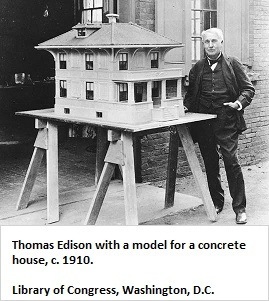
It was, nevertheless, not until the summer of 1880 that Edison determined that carbonized bamboo fibre made a satisfactory material for the filament, although the world's first operative lighting system had been installed on the steamship Columbia in April. The first commercial land-based “isolated” (single-building) incandescent system was placed in the New York printing firm of Hinds and Ketcham in January 1881. In the fall a temporary, demonstration central power system was installed at the Holborn Viaduct in London, in conjunction with an exhibition at the Crystal Palace. Edison himself supervised the laying of the mains and installation of the world's first permanent, commercial central power system in lower Manhattan, which became operative in September 1882. Although the early systems were plagued by problems and many years passed before incandescent lighting powered by electricity from central stations made significant inroads into gas lighting, isolated lighting plants for such enterprises as hotels, theatres, and stores flourished—as did Edison's reputation as the world's greatest inventor. One of the accidental discoveries made in the Menlo Park laboratory during the development of the incandescent light anticipated the British physicist J.J. Thomson's discovery of the electron 15 years later. In 1881–82 William J. Hammer, a young engineer in charge of testing the light globes, noted a blue glow around the positive pole in a vacuum bulb and a blackening of the wire and the bulb at the negative pole. This phenomenon was first called “Hammer's phantom shadow,” but when Edison patented the bulb in 1883 it became known as the “Edison effect.” Scientists later determined that this effect was explained by the thermionic emission of electrons from the hot to the cold electrode, and it became the basis of the electron tube and laid the foundation for the electronics industry. Edison had moved his operations from Menlo Park to New York City when work commenced on the Manhattan power system. Increasingly, the Menlo Park property was used only as a summer home. In August 1884 Edison's wife, Mary, suffering from deteriorating health and subject to periods of mental derangement, died there of “congestion of the brain,” apparently a tumour or hemorrhage. Her death and the move from Menlo Park roughly mark the halfway point of Edison's life. Source: "Edison, Thomas Alva." Encyclopædia Britannica Ultimate Reference Suite, 2013. |
|
(Homology) in biology, (refers to a) similarity of the structure, physiology, or development of different species of organisms based upon their descent from a common evolutionary ancestor. Homology is contrasted with analogy, which is a functional similarity of structure based not upon common evolutionary origins but upon mere similarity of use. Thus the forelimbs of such widely differing mammals as humans, bats, and deer are homologous; the form of construction and the number of bones in these varying limbs are practically identical, and represent adaptive modifications of the forelimb structure of their common early mammalian ancestors. Analogous structures, on the other hand, can be represented by the wings of birds and of insects; the structures are used for flight in both types of organisms, but they have no common ancestral origin at the beginning of their evolutionary development. A 19th-century British biologist, Sir Richard Owen, was the first to define both homology and analogy in precise terms. When two or more organs or structures are basically similar to each other in construction but are modified to perform different functions, they are said to be serially homologous. An example of this is a bat's wing and a whale's flipper. Both originated in the forelimbs of early mammalian ancestors, but they have undergone different evolutionary modification to perform the radically different tasks of flying and swimming, respectively. Sometimes it is unclear whether similarities in structure in different organisms are analogous or homologous. An example of this is the wings of bats and birds. These structures are homologous in that they are in both cases modifications of the forelimb bone structure of early reptiles. But birds' wings differ from those of bats in the number of digits and in having feathers for flight while bats have none. And most importantly, the power of flight arose independently in these two different classes of vertebrates; in birds while they were evolving from early reptiles, and in bats after their mammalian ancestors had already completely differentiated from reptiles. Thus, the wings of bats and birds can be viewed as analogous rather than homologous upon a more rigorous scrutiny of their morphological differences and evolutionary origins. 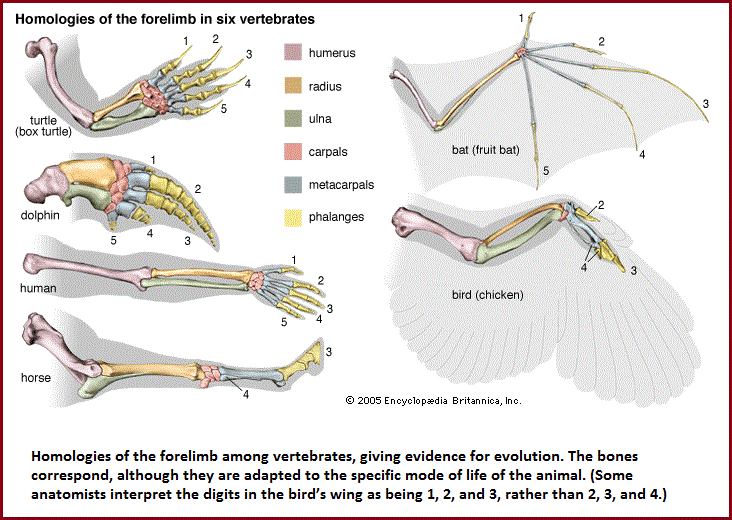 Source: "Homology." Encyclopædia Britannica Ultimate Reference Suite, 2013. |
An image of the foregoing deserves to be followed by another one with a slightly different approach to comparative anatomy, particularly when the enumerated pattern is along the path of computer code referencing (0's, 1's, 2's, 3's). Humorously, perhaps we should design a computer like two animal jaws of teeth. (I = incisor, C = canine, PM = premolar, M = Molar).
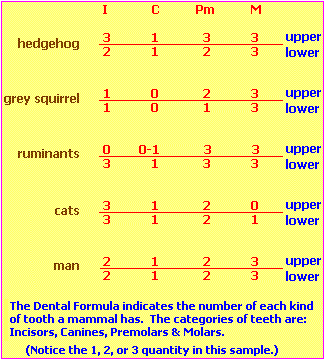
Note: if we pair the central/lateral incisors, premolars/molars; we have two pairs and one single "Canine" description. This results in a set of three: incisors- canines- molars.
A dentition with different kinds of teeth (heterodonty)—incisors, canines, and cheek teeth—is characteristic of all primates and indeed of mammals generally. Heterodonty is a primitive characteristic, and primates have evolved less far from the original pattern than most mammals. The principal changes are a reduction in the number of teeth and an elaboration of the cusp pattern of the molars. The dental formula of primitive placental mammals is assumed to have been 5 . 1 . 4 . 3 / 5 . 1 . 4 . 3 = 44 teeth (the numbers being the numbers respectively of pairs of incisors, canines, premolars, and molars in the upper and lower jaws). No living primate has retained more than two incisors in the upper jaw. The incisors are subject to considerable variation in strepsirrhines. Characteristically, the upper incisors are peglike, one or the other pair often being absent; in the lower jaw, the incisors show a peculiar conformation that has been likened structurally and functionally to a comb. This dental comb is composed of the lower canines and lower incisors compressed from side to side and slanted forward; the most specialized dental combs—seen, for example, in the fork-crowned lemur (genus Phaner) and the needle-clawed galago (genus Euoticus)—are used for scraping exudates off bark, but other species use the structure for piercing fruit, for nipping off leaves, and for grooming the fur. Canines are present throughout the order but show remarkable variation in size, shape, projection, and function. Characteristically, the teeth of Old World monkeys have a function in the maintenance of social order within the group as well as an overtly offensive role; their function as organs of digestion is relatively unimportant. They are large and subject to sexual dimorphism, being larger in males than females. Great apes have smaller canines than Old World monkeys, though still sexually dimorphic; human canines are smaller still, and there is no size difference between the sexes. The trend in the evolution of the cheek teeth has been to increase the number of cusps and reduce the number of teeth. Both molars and premolars show this tendency. No living primate has four premolars; primitive primates, tarsiers, and New World monkeys have retained three on each side of each jaw, but in the apes and Old World monkeys, there are only two premolars. The primitive premolars are uniform in shape and are unicuspid, but in primates the most posterior premolar tends to evolve either one or two extra cusps (molarization), an adaptation that extends the cheek-tooth row for a herbivorous diet. In species with large upper canines, the most anterior lower premolar assumes a peculiar shape known as sectorial, functioning as a hone for the scythelike canine. In humans, whose canines are small and unremarkable, the first and second premolars are identical in shape and two-cusped. The trend in the morphology of the molars has been to increase the primitive three cusps to four or five, the less-insectivorous species having four cusps on the molar crown in the upper jaw and five cusps on the lower. A tendency in smaller New World monkeys has been to reduce the molar series from three to two in both jaws.  Source: "Primate." Encyclopædia Britannica Ultimate Reference Suite, 2013. |
In Reptiles, the jaw can act as an ear when placed to the ground through which vibrations can be "heard" (felt), which is reminiscent of the view concerning a person putting their ear (while resting their boney head) to a rail line in an attempt to hear whether a train is coming or not. No less, I should mention that I once knew someone who thought that the metal used to fill a cavity acted as an antenna which collected radio waves... and this was used to explained the occurrence for the repetition of a song or some news report. They thought that by opening and closing their mouth to different widths allowed them to change the channel of the radio in their mouth. Nonetheless, we are presented with conditions needing to be addressed for developing a higher functioning AI. These are vibration (and hence frequency), involving solid (mechanical-boney-Membranous), liquid (fluidic), and chemical... associated with an electrical environment that we need to implement into circuitry and not in terms of being an auxiliary, actuated or accountable attribute such as seen in servo-mechanisms. (For example, imagine a Membranous integrated circuit that can "vibrate" at different "frequencies" of current.) In other words, we must incorporate such ideas directly into electrical circuit design... they must be the circuit as an integrated component and not an appendage. Let us take a look at a simplified biological integration within the human inner ear:
(Inner Ear) also called labyrinth of the ear, (is the) part of the ear that contains organs of the senses of hearing and equilibrium. The bony labyrinth, a cavity in the temporal bone, is divided into three sections: the vestibule, the semicircular canals, and the cochlea. Within the bony labyrinth is a Membranous labyrinth, which is also divided into three parts: the semicircular ducts; two saclike structures, the saccule and utricle, located in the vestibule; and the cochlear duct, which is the only part of the inner ear involved in hearing. The cochlear duct forms a shelf across the cochlea dividing it into two sections, the scala vestibuli and the scala tympani. The entire inner ear is bathed in a cushioning fluid, called the endolymph when it lies within the Membranous labyrinth and the perilymph when it separates the bony and Membranous labyrinths. Hearing In the cochlea, both the bony labyrinth and the cochlear duct are coiled in a shape resembling that of a snail shell. Resting along the basilar membrane, which forms the base of the cochlear duct, is an arrangement of sensory cells and supporting cells known as the organ of Corti. This cluster of cells varies in thickness, so that different regions within the cochlea are sensitive to different wavelengths of sound. When sound waves are conducted across the bones of the middle ear, they cause the oval window (a Membranous opening between the middle and inner ears) to move in and out along with the stapes of the middle ear, to which it is attached. The motion of the oval window sets up a wave in the perilymph filling the scala vestibuli of the cochlea. This wave is transmitted across Reissner's membrane (the roof of the cochlear duct) into the endolymph of the cochlear duct. It then passes through the tectorial membrane, which forms a roof to protect the organ of Corti, into the organ of Corti. The organ of Corti contains sensory cells with hairlike projections, called hair cells, that are deformed by the progress of the wave. The hair cells trigger nerve impulses that travel along the cochlear nerve, a branch of the auditory nerve, to the brain, where they are interpreted as sound. The sound wave then passes into the perilymph of the scala tympani, where it causes a second membrane-covered opening into the middle ear, the round window, to bulge outward and dampen the wave in the perilymph. The exact physical mechanism of hearing—i.e., the traveling of waves along the basilar membrane—was first correctly explicated by the Hungarian-American physicist Georg von Békésy in the mid-20th century. 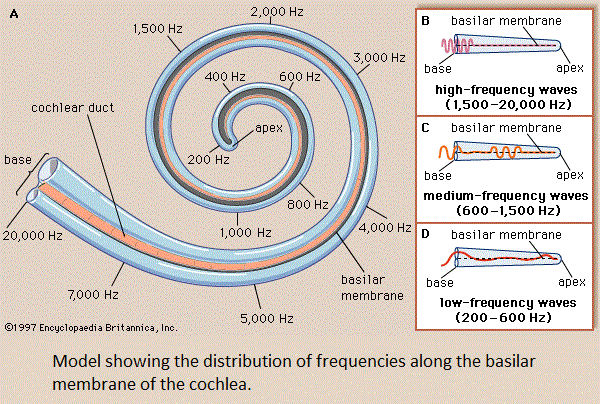 Equilibrium The other divisions of the inner ear—the vestibule and the semicircular canals—are involved in the sense of equilibrium. Each has an organ containing hair cells similar to those of the organ of Corti. The utricle and saccule each contain a macula, an organ consisting of a patch of hair cells covered by a gelatinous membrane containing particles of calcium carbonate, called otoliths. Motions of the head cause the otoliths to pull on the hair cells, stimulating another auditory nerve branch, the vestibular nerve, which signals the position of the head with respect to the rest of the body. The three semicircular canals are arranged at right angles to each other, so that they measure motions in all three planes. Within each semicircular canal is a semicircular duct. Each duct ends in a swelling called an ampulla, which houses a ridge called the ampullary crest (or crista), containing still more hair cells. These cells respond to motion of the endolymph fluid caused by motion of the head in any direction; they transmit signals indicating changes of position through the vestibular nerve. Source: "Inner Ear." Encyclopædia Britannica Ultimate Reference Suite, 2013. |
Subject page first Originated (saved into a folder): Thursday, November 13, 2014... 5:50 AM
Page re-Originated: Sunday, 24-Jan-2016... 08:51 AM
Initial Posting: Saturday, 13-Feb-2016... 10:59 AM
Updated Posting: Monday, 24-June-2019... 10:24 AM
Herb O. Buckland
herbobuckland@hotmail.com